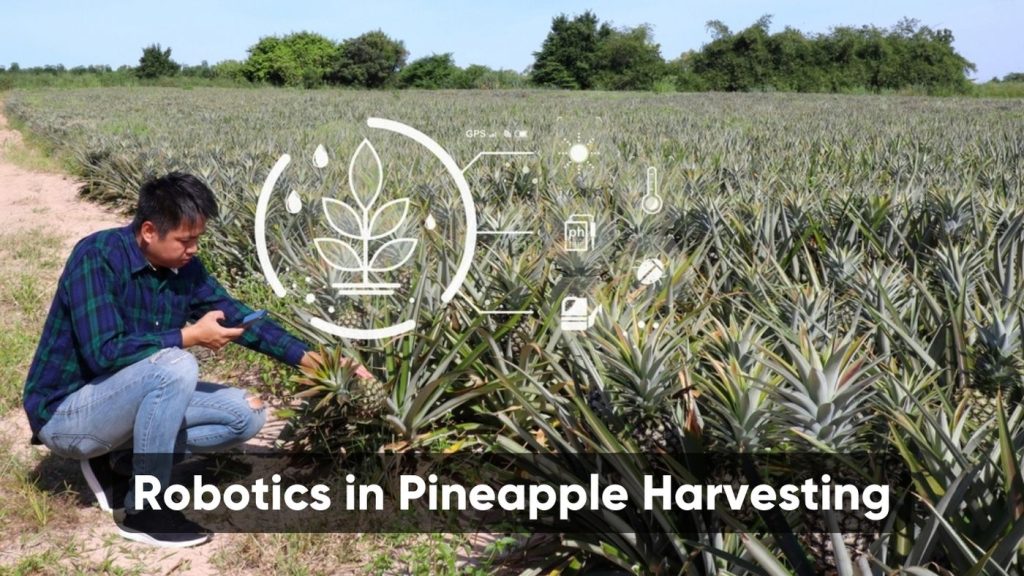Revolutionizing Pineapple Harvesting: The Role of AI-Driven Robotics in Transforming Agriculture
Pineapple harvesting has traditionally been a labor-intensive and time-consuming process, requiring manual labor for the careful extraction of the fruits from the plants. However, with advancements in technology, particularly in the field of robotics and artificial intelligence (AI), a paradigm shift is occurring in the way pineapples are harvested.
This article delves into the innovative world of robotics in pineapple harvesting, exploring how AI-driven robots are revolutionizing this agricultural sector by significantly enhancing efficiency and reducing costs.

The Challenge of Traditional Pineapple Harvesting
Traditional pineapple harvesting involves skilled laborers manually cutting and collecting the fruit from the plants. This method is not only physically demanding but also time-consuming, leading to increased costs for pineapple farmers. The need for a more efficient and cost-effective approach has driven the integration of robotics and AI into the pineapple harvesting process.
The Emergence of AI-Driven Robots in Agriculture
In recent years, there has been a growing trend in the agricultural sector towards automation and the use of AI-driven robots. These robots are equipped with advanced sensors, cameras, and machine learning algorithms, enabling them to perform complex tasks previously reserved for human labor. The integration of these technologies into pineapple harvesting machinery is transforming the industry.
Efficiency Gains through Robotics
One of the primary advantages of using AI-driven robots in pineapple harvesting is the significant improvement in efficiency. These robots can work tirelessly for extended periods, without the need for breaks or rest, leading to a substantial increase in harvesting speed. The precision and accuracy of these robots also ensure that only ripe pineapples are harvested, reducing waste and optimizing overall yield.
AI and Machine Learning Algorithms in Pineapple Harvesting Robots
The intelligence of these robots lies in their ability to adapt and learn from their surroundings. AI algorithms enable the robots to identify ripe pineapples through advanced computer vision, ensuring that only the optimal fruits are harvested.
Machine learning algorithms continuously improve the robot’s performance over time, enhancing their ability to make real-time decisions in the ever-changing environment of a pineapple plantation.
Sensor Technology Enhancing Robotic Capabilities
AI-driven robotic harvesters are equipped with a range of sensors that play a crucial role in navigating the challenging terrain of a pineapple plantation. Lidar sensors help in mapping the surroundings, while proximity sensors prevent collisions with obstacles. These technologies work in tandem to ensure that the robot can move efficiently through the plantation, avoiding damage to both the plants and the machinery.
Cost Reductions and Increased Profitability
While the initial investment in AI-driven robotic harvesting technology may seem substantial, the long-term benefits outweigh the costs. The increased efficiency and reduced labor requirements lead to significant cost savings for pineapple farmers.
The robots’ ability to operate 24/7 also ensures that harvesting can be completed in a shorter time frame, allowing farmers to bring their products to market faster and potentially increasing profits.
Addressing Labor Shortages
In many agricultural regions, labor shortages have become a significant challenge for pineapple farmers. The introduction of AI-driven robotic harvesters addresses this issue by providing a reliable and efficient alternative to human labor.
This not only mitigates the impact of labor shortages but also ensures that the harvesting process is not affected by external factors such as weather conditions or seasonal fluctuations in the availability of manual labor.
Environmental Considerations
The use of AI-driven robots in pineapple harvesting also brings environmental benefits. These robots operate with precision, minimizing damage to the plants and reducing waste. Additionally, the efficiency gains mean that fewer resources, such as fuel for traditional harvesting machinery, are required. This aligns with the growing emphasis on sustainable and environmentally friendly agricultural practices.
Future Developments and Integration of Robotics
As technology continues to advance, the capabilities of AI-driven robotic harvesters are likely to evolve further. Future developments may include enhanced machine learning algorithms, improved sensor technologies, and increased autonomy for the robots.
The integration of robotics into other aspects of pineapple cultivation, such as planting and maintenance, may also become more prevalent, creating a fully automated and streamlined agricultural process.
Challenges and Considerations
While the integration of AI-driven robotics in pineapple harvesting brings numerous benefits, there are challenges and considerations that need to be addressed. Issues such as initial investment costs, technical maintenance, and the potential impact on employment in the agricultural sector should be carefully examined. It is crucial to strike a balance between technological innovation and the well-being of the local communities and workforce.
Conclusion
The use of AI-driven robots in pineapple harvesting marks a significant step towards a more efficient, sustainable, and economically viable agricultural future. By harnessing the power of artificial intelligence, these robots are transforming the traditional labor-intensive process into a streamlined and high-tech operation.
As technology continues to advance, the integration of robotics in agriculture is likely to become more widespread, leading to increased productivity, reduced costs, and a brighter future for pineapple farmers around the world.






